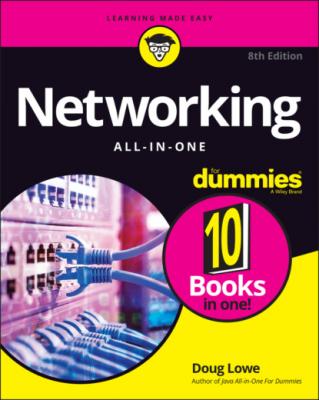Networking All-in-One For Dummies. Doug Lowe
Читать онлайн.| Название | Networking All-in-One For Dummies |
|---|---|
| Автор произведения | Doug Lowe |
| Жанр | Зарубежная компьютерная литература |
| Серия | |
| Издательство | Зарубежная компьютерная литература |
| Год выпуска | 0 |
| isbn | 9781119689058 |
3 Chapter 3: IP Addresses Understanding Binary Introducing IP Addresses Classifying IP Addresses Subnetting Pondering Ports Understanding Network Address Translation
4 Chapter 4: Routing Considering the Usefulness of Routers Understanding Routing Tables
5 Chapter 5: DHCP Understanding DHCP Understanding Scopes Working with a DHCP Server How to Configure a Windows DHCP Client
6 Chapter 6: DNS Understanding DNS Names Top-Level Domains The Hosts File Understanding DNS Servers and Zones Understanding DNS Queries Zone Files and Resource Records Reverse Lookup Zones Working with the Windows DNS Server How to Configure a Windows DNS Client
7 Chapter 7: TCP/IP Tools and Commands Using the arp Command Using the hostname Command Using the ipconfig Command Using the nbtstat Command Using the netstat Command Using the nslookup Command Using the pathping Command Using the ping Command Using the route Command Using the tracert Command
Chapter 1
Network Protocols and Standards
IN THIS CHAPTER
Protocols and standards make networks work together. Protocols make it possible for the various components of a network to communicate with each other, and standards make it possible for different manufacturers’ network components to work together. This chapter introduces you to the protocols and standards that you’re most likely to encounter when building and maintaining a network.
Understanding Protocols
A protocol is simply a set of rules that enable effective communications to occur. You encounter protocols every day and probably don’t even realize it. When you pay for groceries with a debit card, the clerk tells you how much the groceries cost, and then you swipe your debit card in the card reader, punch in your security code, indicate whether you want cash back, enter the amount of the cash back if you so indicated, and verify the total amount. You then cross your fingers behind your back and say a quiet prayer while the machine authorizes the purchase. Assuming the amount is authorized, the machine prints out your receipt.
Here’s another example of an everyday protocol: making a phone call. You probably take most of the details of the phone-calling protocol for granted, but it’s pretty complicated if you think about it:
When you pick up a phone, you listen for a dial tone before dialing the number (unless you’re using a cellphone). If you don’t hear a dial tone, you know that someone else in your family is talking on the phone, or something is wrong with your phone.
When you hear the dial tone, you dial the number of the party you want to reach. If the person you want to call is in the same area code, you simply dial that person’s seven-digit phone number. If the person is in a different area code, you dial 1, the three-digit area code, and the person’s seven-digit phone number.
If you hear a series of long ringing tones, you wait until the other person answers the phone. If the phone rings a certain number of times with no answer, you hang up and try again later. If you hear a voice say, “Hello,” you begin a conversation with the other party. If the person on the other end of the phone has never heard of you, you say, “Sorry, wrong number,” hang up, and try again.
If you hear a voice that rambles on about how they’re not home but they want to return your call, you wait for a beep and leave a message.
If you hear a series of short tones, you know the other person is talking to someone else on the phone. So you hang up and try again later.
If you hear a sequence of three tones that increase in pitch, followed by a recorded voice that says “We’re sorry …” you know that the number you dialed is invalid. Either you dialed the number incorrectly, or the number has been disconnected.
You get the point. Exchanges — using a debit card or making a phone call — follow the same rules every time they happen.
